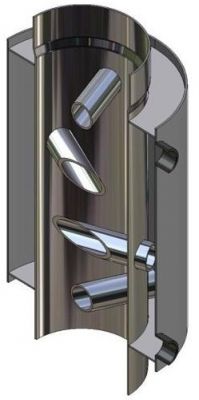FAQ
TL;DR: DIY “turbo smoke” heat recovery can work, but manage fouling and condensation; typical wood use is 6–8 m³/year and, as one user warns, “Cooling the exhaust gases can always cause unexpected problems.” [Elektroda, gaz4, post #16843283]
Why it matters: This FAQ helps DIYers decide materials, cleaning, and safety for fi150/fi200 chimney water inserts while avoiding damage and draft loss.
Quick Facts
- 2 mm black steel will operate, but expect short life; one user estimates it may last only one season. [Elektroda, stanislaw1954, post #16823470]
- Acid‑resistant (stainless) steel is the preferred material over black steel for durability. [Elektroda, roman 18, post #16823455]
- Annual removal and thorough scrubbing are required due to soot between tubes. [Elektroda, Tomasz Downacki, post #16840615]
- Fouling can clog passages enough to impair the chimney draft and is not easily cleanable. [Elektroda, Rezystor240, post #16840669]
- Over‑cooling flue gas can condense water, crumble masonry, and crack bricks in frost. [Elektroda, gaz4, #16843283
Is a 2 mm black pipe OK for a DIY water insert?
It will work, but service life is short versus boiler or stainless steel. One user estimates it might last only one heating season. If you build it, monitor for corrosion and plan for inspection. Consider thicker or acid‑resistant steel for longevity to reduce replacements and labor. [Elektroda, stanislaw1954, post #16823470]
Should I choose acid‑resistant or boiler steel instead of black steel?
Yes. Builders recommend acid‑resistant (stainless) steel for better durability against condensate and corrosive deposits. It resists pitting and extends service intervals compared with black steel. If budget allows, this is the safer long‑term choice for flue‑gas contact. [Elektroda, roman 18, post #16823455]
What do the inner tubes in the photo actually do?
They take heat directly from the exhaust gases. Soot builds up in the gaps between tubes, so you must remove the unit and scrub it thoroughly. Expect routine fouling in these narrow passages, making access and cleaning design critical. [Elektroda, Tomasz Downacki, post #16840615]
How often should I clean a turbo smoke insert?
Plan on a full removal and thorough scrubbing every heating season. Narrow gaps trap soot, which insulates and reduces heat transfer. Design the assembly for easy disassembly so annual maintenance is practical and safe. [Elektroda, Tomasz Downacki, post #16840615]
Can fouling actually block the chimney and become dangerous?
Yes. Users report these inserts are hard to clean and can clog to the point that chimney draft is impaired. That raises smoke‑back and CO risk. If you cannot guarantee cleaning access, do not install a multi‑tube cooler in the flue path. [Elektroda, Rezystor240, post #16840669]
Does a bypass damper help reduce soot and maintenance?
Yes. Use a damper to send flue gas straight up during startup or refueling, then route it through the heat‑recovery path after clean combustion stabilizes. This reduces tar deposition and keeps passages clearer. [Elektroda, gaz4, post #16845433]
How do I operate a bypass damper with a storage‑mass path?
- Ignite the fire with the damper vertical to send flue gas directly to the chimney.
- Wait for a stable, clean flame to appear.
- Turn the damper horizontal to route gas downward through the storage mass and heat‑recovery section.
“Correct combustion… occurs then after a few seconds.” [Elektroda, gaz4, post #16845433]
Is this approach worthwhile for pellet stoves?
Yes. A pellet appliance’s steady, clean burn makes a turbo smoke-style heat recovery more viable. The smoother combustion profile limits heavy soot formation compared with batch‑fired wood. [Elektroda, roman 18, post #16842037]
What’s the main risk of cooling flue gases too much?
Over‑cooling causes water vapor to condense in the chimney. That moisture can crumble masonry and crack bricks during frost. One user cites typical wood use of 6–8 m³/year and warns about wet flue effects. “Cooling the exhaust gases can always cause unexpected problems.” [Elektroda, gaz4, post #16843283]
Are the extra edging tubes necessary?
No. A contributor advises skipping those tubes because they add fouling and maintenance without clear benefit. Focus on a bypassable, accessible heat‑recovery section instead of cluttering the flue path. [Elektroda, gaz4, post #16842065]
What do chimney sweeps think about these DIY inserts?
Expect scrutiny. One participant cautions it’s “asking for trouble” unless operated skillfully with clear maintenance planning. Discuss any insert or cooler with your chimney professional before installation. [Elektroda, wnoto, post #16842540]
Is the water insert supposed to be non‑pressurized?
The thread treats the concept as a non‑pressure design, highlighted by a user explicitly asking to confirm it is non‑pressurized. Build and test only as an open, non‑pressurized loop. [Elektroda, jdubowski, post #16840686]
What thickness do commercial units use, and what do they cost?
One user notes a manufacturer uses 4 mm boiler steel, selling around PLN 700. A DIY version in 2 mm black steel could cost under PLN 150, but durability drops. [Elektroda, Tomasz Downacki, post #16823289]
How can I cut soot when burning logs in a batch‑fired boiler?
Ensure correct combustion with good air supply, and use top‑down firing. Keep the bypass open until flames stabilize. Users report cleaner flue gas and less fouling with this routine. [Elektroda, gaz4, post #16842065]
Do I need to change wood selection or storage for a cooled‑flue setup?
Yes. Use well‑seasoned wood and avoid species that tar heavily. One user needed 12–16 m³ on hand for two‑season drying to support 6–8 m³ yearly use. Poorly dried wood accelerates condensation and damage. [Elektroda, gaz4, post #16843283]
Will this be easy to clean after a season?
No. Users emphasize that multi‑tube coolers with narrow gaps are difficult to clean thoroughly. Design for removal and consider simpler paths you can bypass during lighting and refueling. [Elektroda, Rezystor240, post #16840669]




